Complete Solutions to MULTIPLE CHOICE QUESTION BANK (MCQB) of chapter CARBOXYLIC ACIDS of Class 12 book with complete answers and questions
| Class 12 | CHEMISTRY |
| Chapter | CARBOXYLIC ACIDS |
| DINESH COMPANION CHEMISTRY | MULTIPLE CHOICE QUESTION BANK (MCQB) |
| Number Of Questions | 100 |
| Academic Year | 2023-24 |
In which of the following the number of carbon atoms are not the same when carboxylic acid is obtained by oxiadation ?
02:34View SolutionOn bromination, propionic acid gives two isomeric 2-bromopropionic acids. This pair is an example of
02:20View SolutionSodium formate on heating yields
00:59View SolutionAn ester is boiled with KOH and the product is cooled and acidified with concentrated HCl. A white crystalline precipitate separates out. The ester is :
02:43View SolutionCarbonation of methyl magnesium bromide gives an organic compound which can also be obtained by :
02:58View SolutionWhich of the following on oxidation followed by hydrolysis gives acetic acid ?
02:08View SolutionThe storngest acid among the following is :
02:59View SolutionWhen 2-hydroxybenzoic acid is distilled with zinc dust, it gives :
01:28View SolutionWhich represents the correct order of relative acidic strengths ?
02:39View Solution`[Ag(NH_(3))_(2)]OH` forms metallic silver when it reacts with :
02:36View SolutionThe intermediates formed during the reaction of `R-overset(O)overset(||)C-NH_(2)` with `Br_(2)` and KOH are :
04:47View SolutionIn a set of the given reactions, acetic acid yields a product C.
`CH_(3)COOH+PCl_(5)rarrA`
`A underset("Anhy" AlCl_(3))overset(C_(6)H_(6))rarrBunderset("Ether")overset(C_(2)H_(5)MgBr)rarrC`
Product C would be03:46View SolutionIn the reaction
`CH_(3)CHO+HCNrarrCH_(3)CH(OH)CNoverset(H_(2)O)rarrCH_(3)CH(OH)COOH`
an asymmertic cabron is generated. The acid obtained would be01:56View Solution`o-Toluic` acid on reaction with `Br_(2) + Fe` gives
01:51View SolutionIn a set of reactions, acetic acid yielded a product D.
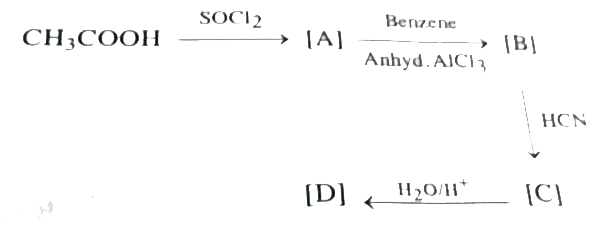
The structure of D would be :04:11View SolutionIn a set of reactions propionic acid yielded a compound `D`
`CH_(3)CH_(2)COOHoverset(SOCI_(2))rarrBoverset(NH_(3))rarrCunderset(Br_(2))overset(KOH)rarrD` The structure of `D` would be .01:37View SolutionWhich of the following represents the correct order of the acidic strength in the given compounds ?
03:02View SolutionIn a set of reaction m-bromobenzoic acid gives a product `D`. Identify the product `D`
 03:12View Solution
03:12View SolutionAn orgainc compound A upon reacting with `NH_(3)` gives `B` On heating `B` give `C.C` in presence `KOH` reacts with `Br_(2)` to yield `CH_(3)CH_(2)NH_(2) A` is .
03:31View SolutionWhich of the following acids does not exhibit optical isomerism?
02:55View SolutionMethylbenzoate can he prepared by :
04:04View SolutionWhich of the following reactions involves the formation of a methyl ester from a carboxylic acid ?
02:35View SolutionThe enolic form of ethyl acetoacetate as shown below has
 01:55View Solution
01:55View SolutionGlutaric acid is :
01:09View SolutionThe correct order of strengths of the carboxylic acids
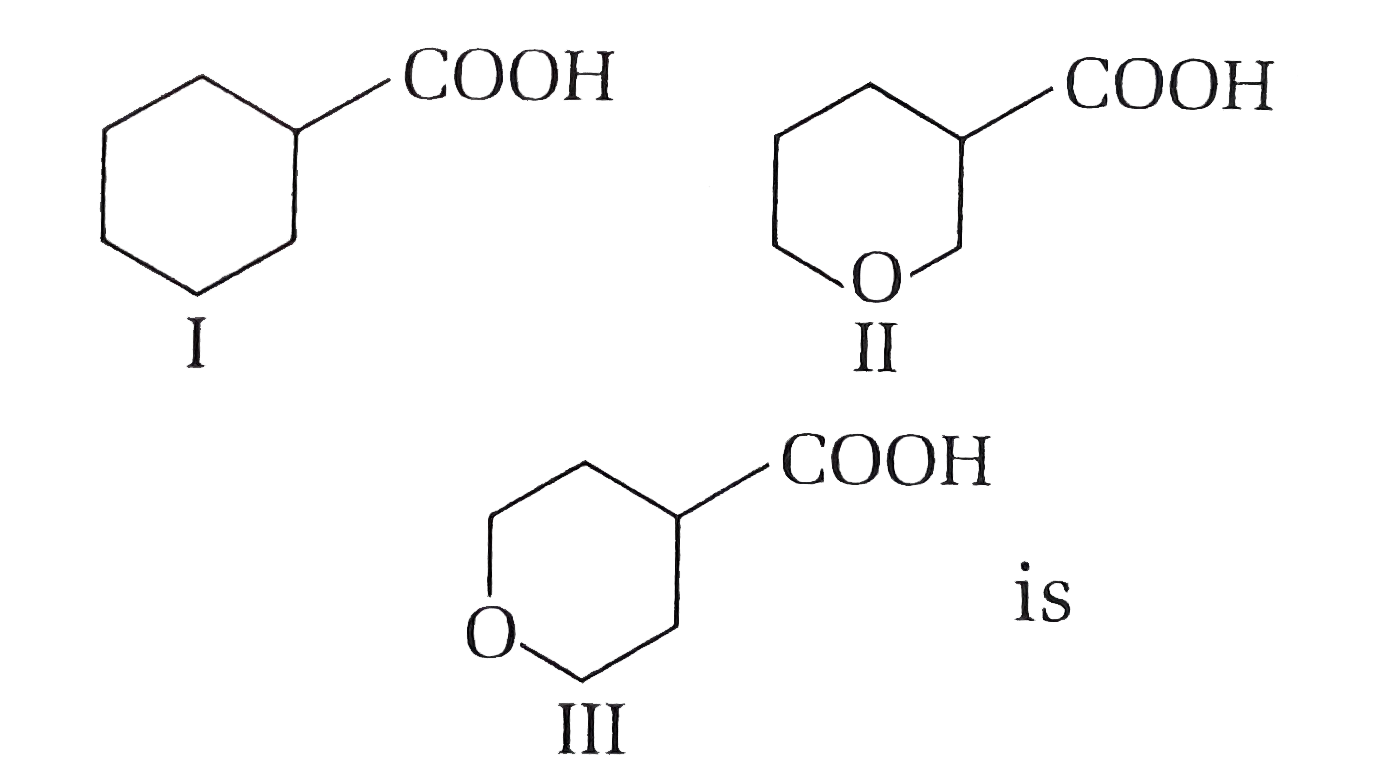 04:38View Solution
04:38View SolutionCarboxylic acid have higher boiling points than aldehydes, ketones and even alcohol of comparable molecular mass. It is due to their
02:07View SolutionWhat are the suitable reagents for the following conversion ?
 03:49View Solution
03:49View SolutionWhich is the strongest acid ?
02:40View SolutionAcrylic acid reacts with HBr to give :
02:21View SolutionWhich of the following cannot reduce fehling's solution and tollen's reagent?
01:56View SolutionWhat is the main fact which supports that carboxylic acids can undergo ionization?
01:02View SolutionWhich is the strongest acid ?
03:20View Solution59 gram of an amide obtained from a carboxylic acid (RCOOH) upon heating with alkali liberated 17g of `NH_(3)` The acid is :
02:50View SolutionThe correct order of acid strengths of benzoic acid (X) peroxybenzoic acid (Y) and p-nitrobenzoic acid (Z) is
05:45View SolutionWhich of the following esters is formed by reacting propan-2-01 with ethanoic acid ?
03:18View SolutionConsider the following reaction
Phenol `overset(Zn)underset("dust")rarr X overset(CH_(3)Cl)underset(underset(AlCl_(3))("Anhydrous"))rarr Y overset("Alkaline")underset(KMnO_(4))rarrZ`
The product Z is02:47View SolutionThe ease of esterification of the acids `HCO OH(I),CH_(3)CO OH(II),and CH_(3)CH_(2)C O OH(III)` with `CH_(3)OH` is
02:57View SolutionWhich of the following will evolve `N_(2)` gas with `Br_(2)//KOH` ?
01:28View SolutionWhich of the following has the maximum acidic strength?
03:30View SolutionThe compound B is :
`CH_(3)CH_(2)COOH overset(Cl_(2))underset(red P)rarrAoverset(Alc. KOH)rarrB`01:17View SolutionThe compound is used as
 01:40View Solution
01:40View SolutionThe compound formed as a result of oxidation of ethyl benzene by `KMnO_(4)` is
02:27View SolutionWhen `CH_(2) = CHCOOH` is reduced with `LiAIH_(4)`., the compound obtained is
02:14View SolutionAmong the following the lowest `pK_(a)` value is of :
02:42View SolutionThe correct order of increasing acidic strength of the compounds:
 05:19View Solution
05:19View SolutionThe correct order of increasing acidity of the followins is :
03:20View SolutionThe final product in the given reaction is
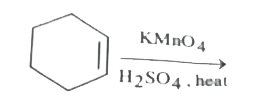 02:23View Solution
02:23View SolutionWhich of the following compound will have the smallest `pK_(a)` value ?
02:21View SolutionArrange the following acids in order of their increasing acidity
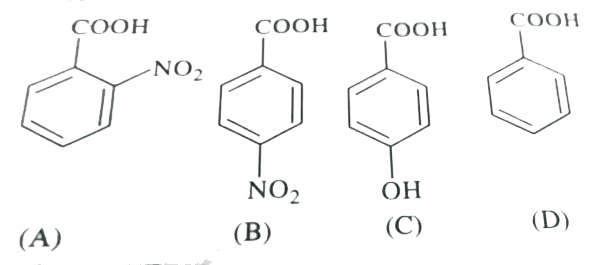 02:36View Solution
02:36View SolutionWhen propionic acid is treated with aqueous sodium bicarbonate, `CO_(2)` is liberated. The carbon of `CO_(2)` comes from
01:30View SolutionThe strongest acid among the following compounds is :
02:31View SolutionWhich of the following can distringuish phenol and benzoic acid ?
01:46View SolutionAn orgainc compound A upon reacting with `NH_(3)` gives `B` On heating `B` give `C.C` in presence `KOH` reacts with `Br_(2)` to yield `CH_(3)CH_(2)NH_(2) A` is .
03:31View SolutionIn the reaction
`CH_(3)COOHoverset(LiAlH_(4))rarrAoverset(PCl_(4))rarrBoverset(Alc.KCN)rarrC`
The product C is04:25View SolutionPerdict the product (C) of the following sequence of reactions :
`CH_(3)COOHoverset(PCl_(5))rarr[A]overset(C_(6)H_(6))underset("Anhyd."AlCl_(3))rarr[B]overset(CH_(3)MgBr)underset(H_(2)O^(+))rarr[C]`03:38View SolutionWhich order is improper for acidic strength ?
View SolutionThe correct increasing order of the acid strength fo acids, butyric acid (I), 2-chlorobutyric acid (II), 3-chlorobutyaric acid (III), 2,2-dichlorobutyric acid (IV) is :
04:20View SolutionThe reaction sequence given below gives products R.

The structure of the product R is02:09View SolutionAn organic compound [A] is `C_(5)H_(8)O_(3).`On heating with soda lime, it gives [B]. The compound [B] reacts with HCN to give another compound [C] which reacts with thionyl chloride to produce [D]. When the compound [A] is heated with potassium dichromate the product is acetic acid and malonic acid.
The compound [A] is a03:47View SolutionAn organic compound [A] is `C_(5)H_(8)O_(3).`On heating with soda lime, it gives [B]. The compound [B] reacts with HCN to give another compound [C] which reacts with thionyl chloride to produce [D]. When the compound [A] is heated with potassium dichromate the product is acetic acid and malonic acid.
The structure of compound [A] is :02:54View SolutionAn organic compound [A] is `C_(5)H_(8)O_(3).`On heating with soda lime, it gives [B]. The compound [B] reacts with HCN to give another compound [C] which reacts with thionyl chloride to produce [D]. When the compound [A] is heated with potassium dichromate the product is acetic acid and malonic acid.
The IUPAC name of compound [B] is :02:34View SolutionA compound [A] has the formula `C_(4)H_(8)O_(2)`. When reacted with a Grignard reagent, `CH_(3)MgBr`, it takes up two molecules of it and upon acidification gives an alcohol [B]. The alcohol on reacting with Lucas reagent gives white coludiness on standing for sometime. When the alochol is oxidised, a compound [C] is produced with a pleasant smell. It neither reacts with Tollen's reagent, nor with Fehling's reagent.
The compound [A] is02:17View SolutionA compound [A] has the formula `C_(4)H_(8)O_(2)`. When reacted with a Grignard reagent, `CH_(3)MgBr`, it takes up two molecules of it and upon acidification gives an alcohol [B]. The alcohol on reacting with Lucas reagent gives white coludiness on standing for sometime. When the alochol is oxidised, a compound [C] is produced with a pleasant smell. It neither reacts with Tollen's reagent, nor with Fehling's reagent.
The compound [A] is02:34View SolutionA compound [A] has the formula `C_(4)H_(8)O_(2)`. When reacted with a Grignard reagent, `CH_(3)MgBr`, it takes up two molecules of it and upon acidification gives an alcohol [B]. The alcohol on reacting with Lucas reagent gives white coludiness on standing for sometime. When the alochol is oxidised, a compound [C] is produced with a pleasant smell. It neither reacts with Tollen's reagent, nor with Fehling's reagent.
The alcohol [B] is01:56View SolutionCarboxylic acids having at least one `alpha`-hydrogen react with `Cl_(2)" or "Br_(2)` in the presnence of red phosphorus to give `alpha`-halo acids. The reaction is known as H.V.Z. reaction. The HVZ reaction is limited to the formation of `alpha`-chloro acid and `alpha`-bromo acid and it is sometimes difficult to carry out the reaction. Answer the following questions :
Which of the following carboxylic acids will not give HVZ reaction ?02:07View SolutionCarboxylic acids having at least one `alpha`-hydrogen react with `Cl_(2)` or `Br_(2)` in the presence of phosphorous to give `alpha`-halo acids. The reaction is known as Hell -volhar-Zelinsky reaction (HVZ reaction).
`R-CH_(2)-CO OH overset(P//Br_(2))underset(Delta)toR-CH(Br)CO OH`
The HVZ reaction is limited to the formation of `alpha`-chloro and `alpha`-bromo acids and it is sometimes backward to carry out. the reagents (`X_(2)` and `P`) are noxious and the reaction time is often long and the conditions of reaction are harsh.
Which of the following will be obtained when acetic acid is subjected to HVZ reaction ?01:53View SolutionCarboxylic acids having at least one `alpha`-hydrogen react with `Cl_(2)` or `Br_(2)` in the presence of phosphorous to give `alpha`-halo acids. The reaction is known as Hell -volhar-Zelinsky reaction (HVZ reaction).
`R-CH_(2)-CO OH overset(P//Br_(2))underset(Delta)toR-CH(Br)CO OH`
The HVZ reaction is limited to the formation of `alpha`-chloro and `alpha`-bromo acids and it is sometimes backward to carry out. the reagents (`X_(2)` and `P`) are noxious and the reaction time is often long and the conditions of reaction are harsh.
`CH_(3)-CO OH overset(Br_(2)//P)to(A) overset(NaCN)to(B) overset(HOH//H^(+))to(C)`
The product (C) will be01:57View SolutionThe acidity of carboxylic acid is determined by the nature of the alkyl group attached and the substiuent present on it. It is affected mainly by the inductive effect of the substituent and its position with respect to the -COOH group. Electron-donating substituent tends to decrease the acidic strength whereas electron-withdrawing substituent tends to increase acidic strength. The acidic strength of aromatic carboxylic acid on the other hand depends upon both the inductive and resonance effects of the substituents.
Which of the following would be expected to be most highly ionized in water ?02:08View SolutionThe acidity of carboxylic acid is determined by the nature of the alkyl group attached and the substiuent present on it. It is affected mainly by the inductive effect of the substituent and its position with respect to the -COOH group. Electron-donating substituent tends to decrease the acidic strength whereas electron-withdrawing substituent tends to increase acidic strength. The acidic strength of aromatic carboxylic acid on the other hand depends upon both the inductive and resonance effects of the substituents.
Which of the following acids has the smallest dissocation constant ?02:29View SolutionThe acidity of carboxylic acid is determined by the nature of the alkyl group attached and the substiuent present on it. It is affected mainly by the inductive effect of the substituent and its position with respect to the -COOH group. Electron-donating substituent tends to decrease the acidic strength whereas electron-withdrawing substituent tends to increase acidic strength. The acidic strength of aromatic carboxylic acid on the other hand depends upon both the inductive and resonance effects of the substituents.
Among the following, the strongest acid is :02:32View SolutionThe acidity of carboxylic acid is determined by the nature of the alkyl group attached and the substiuent present on it. It is affected mainly by the inductive effect of the substituent and its position with respect to the -COOH group. Electron-donating substituent tends to decrease the acidic strength whereas electron-withdrawing substituent tends to increase acidic strength. The acidic strength of aromatic carboxylic acid on the other hand depends upon both the inductive and resonance effects of the substituents.
Which of the following is obtained when 4-methylbenzene sulphonic acid is hydrolyzed with excess of sodium acetate01:36View SolutionChlorination of toluene in the presence of light and heat followed by treatment with aqueous NaOH gives
02:26View SolutionIdentify the final product of the following reaction :
 02:54View Solution
02:54View SolutionConsider the following reaction
`underset("Ester(x)")underset()(C_(4)H_(8)O_(2)) underset("(ii)"H_(3)O^(+))overset((i)CH_(3)MgBr("Excess"))to underset("Alcohol(Y)")underset()(C_(4)H_(10)O)` Alcohol (Y) reacts fastest with Lucas reagent. Therefore (X) and (Y) are04:04View SolutionWhich of the following carboxylic acids undergoes decarboxylation easily ?
02:31View SolutionIn the reaction
`C_(6)H_(5)CO OCH_(3)overset(LiAlH_(4))to?` the products formed are02:23View SolutionThe molecular weight of benzoic acid in benzene as determined by depression in the freezing point method corresponds to
03:38View SolutionWhich of the following compounds is most susceptible to a nucleophilic attack at the carbonyl group?
02:57View SolutionWhen propionic acid is treated with aqueous sodium bicarbonate, `CO_(2)` is liberated. The carbon of `CO_(2)` comes from
01:30View SolutionEthyl easter `overset(CH_(3)MgBr)underset("excess")rarrP,` the product P is
03:08View SolutionWhen benzamide is treated with `POCl_(3)` the product is
01:18View SolutionWhen
 reacts with `CH_(3)COO^(-)Na^(+)` (excess), the 01:12View Solution
reacts with `CH_(3)COO^(-)Na^(+)` (excess), the 01:12View SolutionThe correct order of acidity of the following is
 03:28View Solution
03:28View SolutionThe carboxyl functional group `(-COOH)` is present in `:`
02:18View SolutionThe compound that undergoes decarboxylation most readily under mild condition is
02:08View SolutionThe major product(s) of the following reaction is (are)
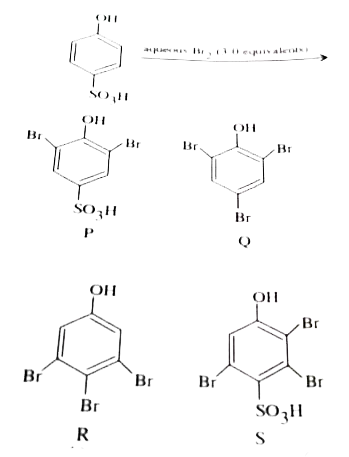 02:02View Solution
02:02View Solution`P` and `Q` are isomers of dicarboxylic acid `C_(4)H_(4)O_(4)`. Bothdecolorize `Br_(2)//H_(2)O`. On heating, `P` forms the cyclic anhydride. Upon treatment with dilute alkaline `KMnO_(4),P` as well as `Q` could produce one or more than one forms `S,T` and `U`.
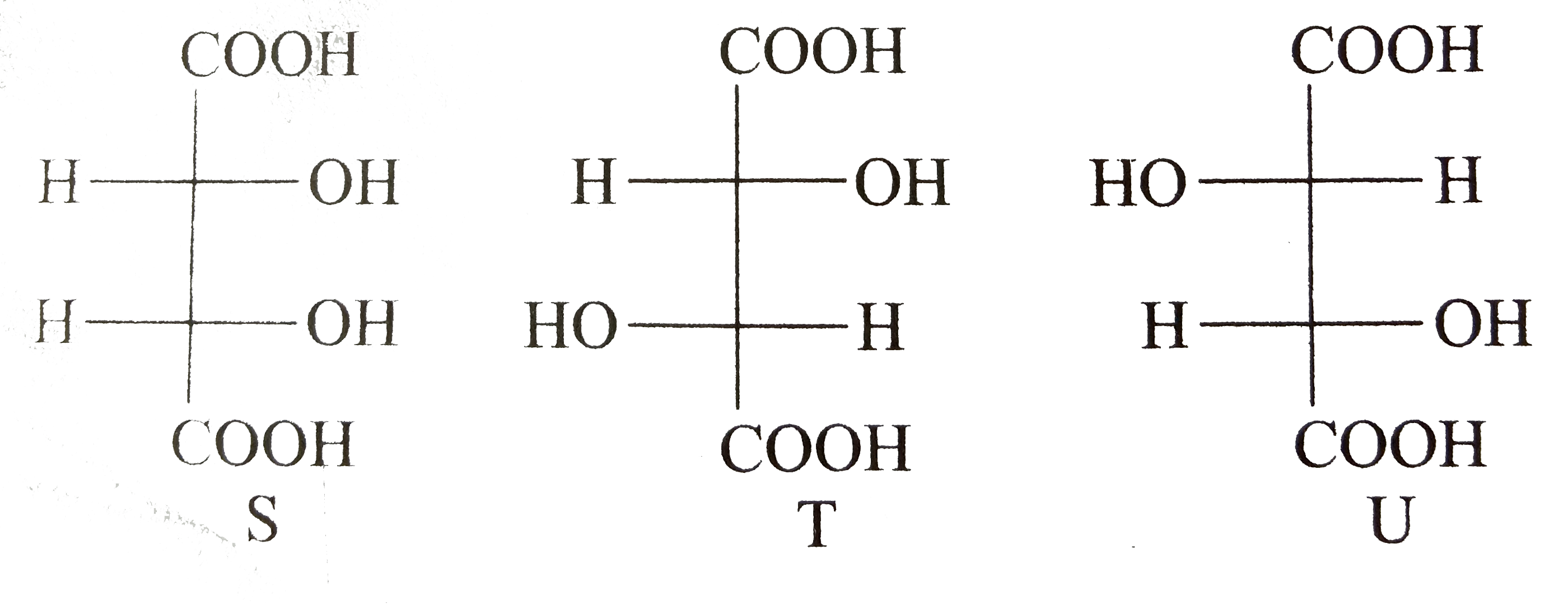 Compounds formed from `P` and `Q` are, respectively02:21View Solution
Compounds formed from `P` and `Q` are, respectively02:21View SolutionAmong the following compounds, the one (s) that gives (gives) effervescence with aqueous `NaHCO_(3)` solution is (are) :
(I) `(CH_(3)CO)_(2)O` , (II) `CH_(3)COOH`
(III) `PhOH` , (IV) `CH_(3)COCHO`02:19View SolutionThe correct order of acidity for the following compounds is
 View Solution
View SolutionThe acids which do not contain a-COOH group are :
02:09View SolutionPhenol and benzoic acid may be distinguished by their reaction with :
02:10View SolutionWhich of the following on oxidation with alkaline `KMnO_(4)` followed by acidification with HCl gives benzoic acid ?
02:02View SolutionWhich of the following statements is/are correct about formic acid?
03:43View SolutionAssertion : Benzoic acid is a weaker acid than formic acid.
Reason : Phenyl group destabilises the carboxylate anion due to conjugation.03:13View SolutionAcetic acid does not undergo haloform reaction.
Acetic acid has no alpha-hydrogen.01:40View SolutionAssertion: Formic acid reduces mercuric chloride to mercurous chloride on heating , while acetic acid does not.
Reason : Formic acid is stronger acid than acetic acid.03:22View SolutionAssertion : Nitration of benzoic acid gives meta nitrobenzoic acid.
Reason : Carboxyl group deactivates the ortho and para positions in the ring.03:08View SolutionAssertion : Carbxoylic acids donot give characteristic reactions of carbonyl group.
Reason : The carbonyl group is sterically hindered in carboxylic acid.03:19View SolutionAssertion : Upon heating an amide with `Br_(2)" and "KOH`, primary amine with one carbon atom less is formed.
Reason : The reaction occurs through occurs through carbene intermediate.02:22View SolutionAssertion : Carboxylic acids are stronger acids than phenols.
Reason : There is a greater dispersal of negative charge on the carboxylate ion than on the phenate ion.04:33View Solution
MULTIPLE CHOICE QUESTION BANK (MCQB) questions and complete solutions for chapter CARBOXYLIC ACIDS of S DINESH & CO CHEMISTRY (HINGLISH) of Class 12
All Exercises from DINESH COMPANION CHEMISTRY Class 12 CHEMISTRY CARBOXYLIC ACIDS
- ADDITIONAL IMPORTANT QUESTIONS
- ASSERTION-REASON TYPE QUESTIONS
- ASSIGNMENT
- BRAIN STORMING MULTIPLE CHOICE QUESTIONS (MCQS)
- COMPLETION OF THE MISSING LINKS
- Example
- HIGHER ORDER THINKING SKILLS (HOTS) QUESTIONS
- LONG ANSWER TYPE QUESTIONS
- MATRIX-MATCH TYPE QUESTIONS
- MULTIPLE CHOICE QUESTION BANK (MCQB)
- N.C.E.R.T. EXERCISE
- N.C.E.R.T. EXMPLAR PROBLEMS
- N.C.E.R.T. IN-TEXT QUESTIONS
- QUESTIONS FROM BOARD EXAMINATIONS
- SHORT ANSWER TYPE QUESTIONS
- SOME TYPICAL WORD PROBLEMS BASED ON CONVERSION
